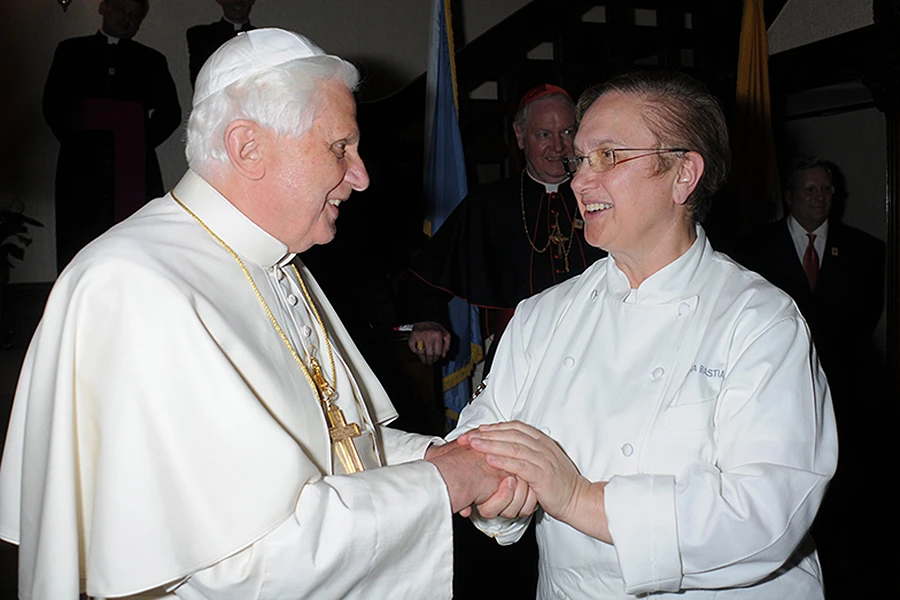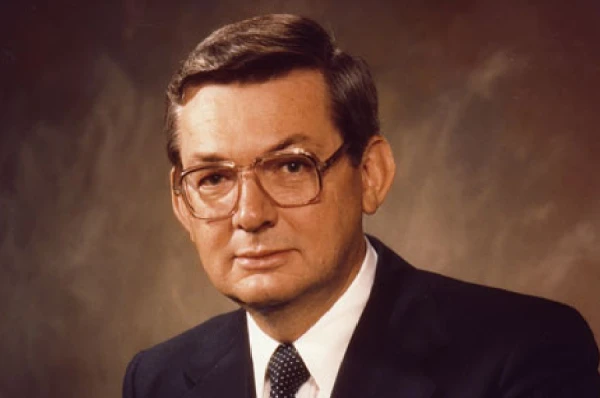
Brooklyn, N.Y., Apr 5, 2018 / 03:01 am (CNA/EWTN News).- If you were asked to cook for the Pope, what would you choose to make? This was a real question for chef Lidia Bastianich in both 2008 and 2015 – the years in which Benedict XVI and Pope Francis visited the United States.
“I remember vividly,” Bastianich told CNA. “It was an extraordinary experience.”
“When I got asked to cook for Pope Benedict, I didn’t believe it was going to happen. I remember I laughed and said, sure, Monsignor, I would love to, but is that a reality?”
Bastianich, 71, is a chef, cookbook author, and restaurateur. An Italian immigrant who came to the United States as a young girl, she is an expert in Italian-American cuisine who has hosted several cooking shows on public television. Her memoir My American Dream was published April 3.
The process of cooking for a pope during an apostolic journey begins well before he arrives, with the formation of a team of chefs and wait staff. From there, the menu of the meals is planned and sent to the Vatican for approval.
Benedict XVI
Doing research, Bastianich learned that Benedict’s mother had been a cook and she thought that he would have “some good food memories” from that time in his life, which she wanted to evoke.
For Benedict XVI they were scheduled to prepare two meals: a large dinner for the pope and around 50 cardinals and bishops the first night, and on the second night a smaller dinner that would also be his 80th birthday celebration.
For the first big dinner the menu included string bean salad with sheep’s milk ricotta, pickled shallots, and toasted almonds; ravioli with pecorino and pears; risotto with nettles, fava beans, and ramps; whole roasted striped bass with boiled fingerling potatoes and a frisee salad. And for dessert: apple strudel with honey vanilla ice cream.
For the dinner celebrating his birthday and his third anniversary as pope, they prepared asparagus salad with pecorino, fava beans, and green chickpeas with lemon and olive oil; and a round, flat pasta filled with meat, called “agnolini,” in chicken broth.
The main dish was a beef goulash with a side of pan-fried potatoes and onions, served with sauerkraut and sour cream for a German touch. Dessert was an apricot and ricotta crostata and a chocolate-hazelnut cake with the words “Tu es Petrus”, topped with a two-foot-tall marzipan mitre.
After the meal, Benedict told Bastianich that the meal was “very good. The flavors of my mother.”
“I was so happy that he ate, that he enjoyed it, that the memories were those of his childhood,” she said. “I wanted to make him feel at home.”
Two special moments she recalls were when they brought in his birthday cake and sang “Happy Birthday” in English and Italian. They handed him the knife to cut the cake, but when he hesitated, Bastianich reached over. “I actually helped him cut it!” she laughed.
Another touching moment, Bastianich noted, took place after the dinner: a diplomat performed a violin sonata and Benedict invited the whole kitchen staff to come, sit down, and listen to the music with him.
Pope Francis
For Pope Francis, Bastianich’s first instinct was to go with an Argentine theme and serve lots of meat, but the Vatican turned down her first menu proposal because Francis must eat lighter things for his health.
Instead she chose to focus on his northern Italian heritage, preparing heirloom tomatoes, house-made burrata, and steamed lobster; capon soup with Grana Padano raviolini, veal medallions, Boscaiola, porcini, corn, and fresh tomato; and concord grape sorbet with angel food cake for his first dinner in New York.
Bastianich and her staff were also in charge of preparing Francis’ breakfasts, though all he wanted each morning was some fresh orange juice, tea, and toast.
They also prepared his bedside table at night with a glass of water and a banana, she said. “I put a few cookies, too. I wasn’t supposed to, but I put a few cookies.”
Friday’s lunch consisted of cooked and raw vegetable salad with ricotta; risotto with porcini, summer truffles, and Grana Padano Riserva; and roasted pears and grapes with vanilla gelato.
At dinner they served pear and pecorino-filled ravioli, aged pecorino, whole roasted striped bass, late summer vegetables with extra virgin olive oil and lemon, and apple crostata with local honey ice cream.
One memory of Pope Francis’s visit stands out for Bastianich in particular. After lunch on Friday, he went to rest in his room, she said. The staff were in the kitchen taking a coffee break and discussing their plans for the next meal when they suddenly heard the pope’s security staff running and shouting “Papa, Papa!”
“And all of a sudden, we see [Pope Francis] enter the kitchen,” she said. “And he peered in and said, “Posso avere un caffe, per favore?” – “Can I have a coffee, please?”
“He sipped on his espresso and he talked to each one of us. He spent a good 20 minutes with us in this simple kitchen, us dressed in our chef clothes. It was so intimate, so wonderful.”
Before leaving, she recalled that “he reached into his pocket and pulled out a rosary for each one of us, and handing it to us said, ‘pregate per me,’ pray for me … It was extraordinary.”
Her Catholic faith
Bastianich has been a Catholic from birth and said that personal prayer is very important to her. “I feel that ever more… I need to talk to God because I need his guidance,” she said.
She also noted that she has a special devotion to the Madonna of the Miraculous Medal, which she carries with her every day.
Despite growing up in communist Yugoslavia, “the faith was always a part of me, I always believed,” she said. Unfortunately, at this time, her family could not go to Mass and she had to be baptized in secret. Her grandmother taught her and her brother prayers when they would visit.
When she was ten years old Bastianich’s family escaped back into Italy, staying for two years in a camp for political refugees before immigrating to the U.S.
A benefactor paid for her to attend a Catholic school run by a religious order and she said that those two years were when she really learned about her faith. During this time, she would also cook with the sisters in the school’s kitchen.
Those years in the refugee camp, when food was scarce, have given her a greater appreciation for helping people out of her abundance, she said. “He gave me so much, but what he gave me is not mine to keep, I have to share, he has to show me the way that I can share what he has given me with others.”
If you value the news and views Catholic World Report provides, please consider donating to support our efforts. Your contribution will help us continue to make CWR available to all readers worldwide for free, without a subscription. Thank you for your generosity!
Click here for more information on donating to CWR. Click here to sign up for our newsletter.




Leave a Reply